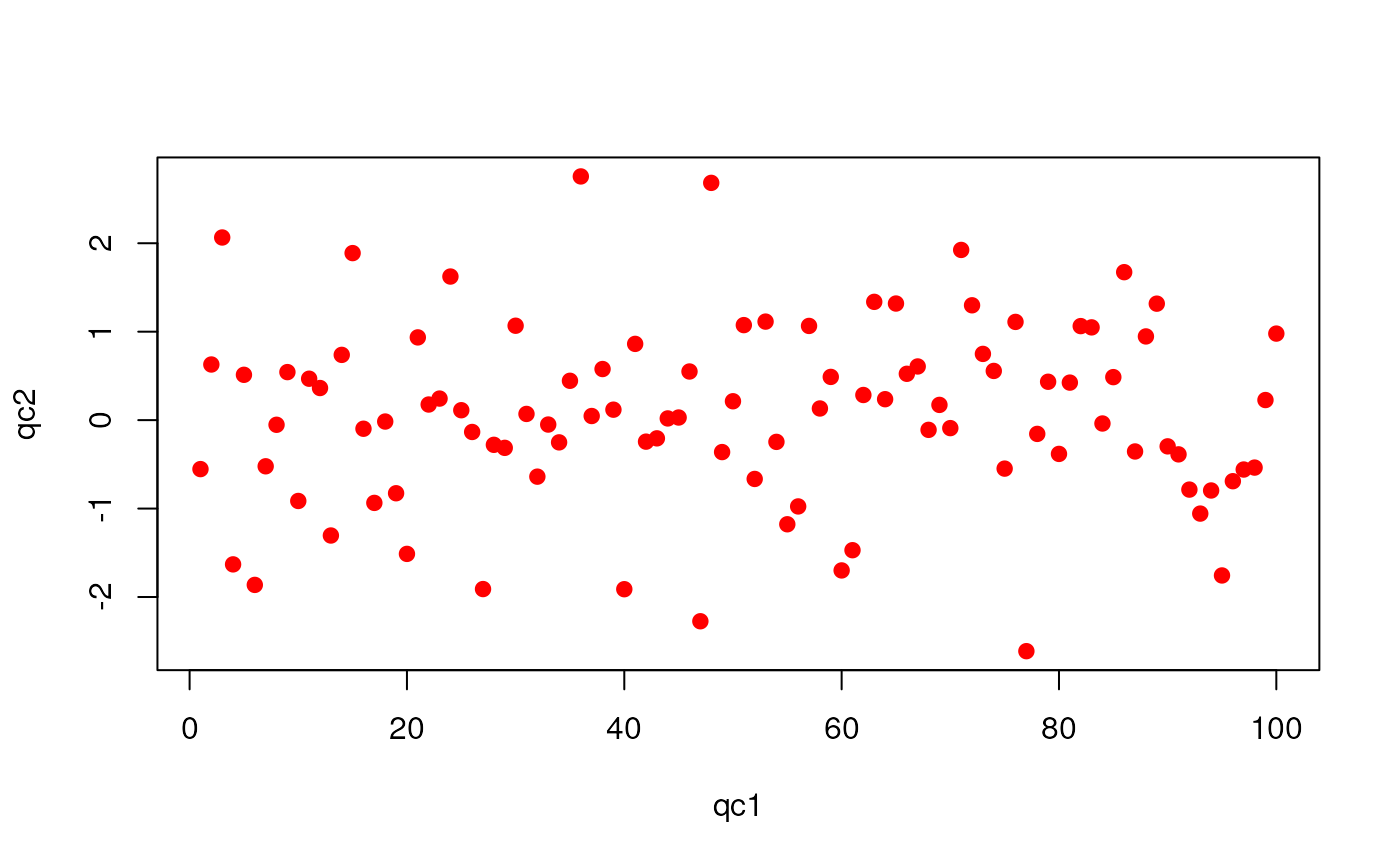The "QcMetric" class for QC items
QcMetric-class.RdData structure for individual QC metrics items.
Objects from the Class
Objects can be created using the constructor QcMetric(...), where
slots are assigned individually. See example below.
Slots
name:Object of class
"character"of length 1 naming theobject.description:Object of class
"character"of arbitrary length describing the qc metric in more details.qcdata:Object of class
"environment"that stores the actual data.plot:Object of class
"function"to graphically represent the data and infer quality status.show:Object of class
"function"to print a short textual representation of theobject. A reasonable default value is provided.status:Object of class
"logical"that indicates weather the data passes (TRUE) or fails (FALSE) the metric or has not yet been evaluated.
Methods
- name
signature(object = "QcMetric"): retrieves the name of theobject.- name<-
signature(object = "QcMetric", value = "character"): set the name of theobject.- description
signature(object = "QcMetric"): retrieves the description of theobject.- description<-
signature(object = "QcMetric", value = "character"): set the description of theobject.- status
signature(object = "QcMetric"): retrieves the status of theobject.- status<-
signature(object = "QcMetric", value = "logical"): sets the status of theobjects.- qcdata
signature(object = "QcMetric", x = "missing"): lists all the dataobjects that are associated with theobjects.- qcdata
signature(object = "QcMetric", x = "character"): retrieves the variablexfor theobject.- qcdata<-
signature(object = "QcMetric", var): creates or overwrites (with a message) the data variablevarby assigning the RHS value. Ifvaris missing and the RHS expression is an environment, thenqcdatais reset with all the variables invalue.- qcenv
signature(object = "QcMetric"): return theenvironmentthat stores the QC data.- qcenv<-
signature(object = "QcMetric"): Set all variable in the RHSenvironmentasqcdatavariables. Equivalent toqcdata(object) <- xwherexis an environment.- show
signature(object = "QcMetric"): shows a textual summary ofobject. The defaultshowimplementation is available as theqcshow{object, qcdata}function. The second argument is a logical (default isTRUE) that specifies whetherqcdata(object)should be displayed.- show<-
signature(object = "QcMetric", value = "function"): sets a customshowmethod forobject.- plot
signature(x = "QcMetric", y = "missing"): plots theobjectusing the provideshowmethod.- plot<-
signature(object = "QcMetric", value = "function"): sets a customplotmethod forobject.- qcReport
signature(x = "QcMetric", ...): to generate quality reports. SeeqcReportfor details.
See also
The QcMetrics class to bundle a set of
QcMetric instances.
Examples
(qc <- QcMetric())
#> Object of class "QcMetric"
#> Name: A QcMetric prototype
#> Status: NA
#> Data: empty
qcdata(qc)
#> character(0)
try(qcdata(qc, "x"))
#> Error in qcdata(qc, "x") : No qcdata 'x' in object.
x <- rnorm(10)
qcdata(qc, "qc1") <- x
qcdata(qc, "qc2") <- 1:10
qcdata(qc)
#> [1] "qc1" "qc2"
all.equal(qcdata(qc, "qc1"), x)
#> [1] TRUE
all.equal(qcdata(qc, "qc2"), 1:10)
#> [1] TRUE
name(qc) <- "My test QcMetric"
description(qc) <- "This qc metric describes bla bla bla, indicating possible issues in the third step of protocol bla bla bla."
status(qc) <- FALSE
qc
#> Object of class "QcMetric"
#> Name: My test QcMetric
#> Description:
#> This qc metric describes bla bla bla, indicating possible issues in the
#> third step of protocol bla bla bla.
#> Status: FALSE
#> Data: qc1 qc2
## or
e <- new.env()
e$qc1 <- rnorm(100)
e$qc2 <- 1:100
qcenv(qc) <- e
length(qcdata(qc, "qc1"))
#> [1] 100
head(qcdata(qc, "qc2"))
#> [1] 1 2 3 4 5 6
show(qc)
#> Object of class "QcMetric"
#> Name: My test QcMetric
#> Description:
#> This qc metric describes bla bla bla, indicating possible issues in the
#> third step of protocol bla bla bla.
#> Status: FALSE
#> Data: qc1 qc2
show(qc) <- function(object) cat("Updated show method\n")
show(qc)
#> Updated show method
show(qc) <- qcshow
qc
#> Object of class "QcMetric"
#> Name: My test QcMetric
#> Description:
#> This qc metric describes bla bla bla, indicating possible issues in the
#> third step of protocol bla bla bla.
#> Status: FALSE
#> Data: qc1 qc2
plot(qc)
#> Warning: No specific plot function defined
plot(qc) <-
function(object, ...)
plot(qcdata(object, "qc2"),
qcdata(object, "qc1"),
xlab = "qc1",
ylab = "qc2",
...)
plot(qc)
 plot(qc, col = "red", pch = 19)
plot(qc, col = "red", pch = 19)
